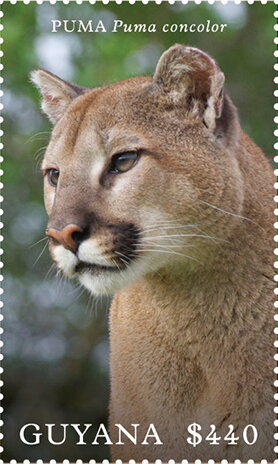Stamp: Puma (Puma concolor) (Guyana 2018)
Puma (Puma concolor) (Guyana 2018)
08 August (Guyana ) within release Wild Cats of Guyana goes into circulation Stamp Puma (Puma concolor) face value 440 Guyanese dollar
| Stamp Puma (Puma concolor) in catalogues | |
|---|---|
| Michel: | Mi: GY 9515 |
| Stamp Number: | Sn: GY 4578d |
| Yvert et Tellier: | Yt: GY 7006 |
| Colnect codes: | Col: GY 2018.08.08-3d |
Stamp is square format.
Footnoted in: Stanley GibbonsAlso in the issue Wild Cats of Guyana:
- Stamp - Margay (Leopardus wiedii) face value 400;
- Stamp - Margay (Leopardus wiedii) face value 400;
- Stamp - Ocelot (Leopardus pardali) face value 420;
- Stamp - Ocelot (Leopardus pardali) face value 420;
- Stamp - Oncilla (Leopardus tigrinus) face value 380;
- Stamp - Oncilla (Leopardus tigrinus) face value 380;
- Stamp - Puma (Puma concolor) face value 440;
- Stamp - Puma (Puma concolor) face value 440;
- Mini Sheet - Wild Cats of Guyana face value 1,640;
- Mini Sheet - Wild Cats of Guyana face value 1,640;
Stamp Puma (Puma concolor) it reflects the thematic directions:
Amphibians are ectothermic, anamniotic, four-limbed vertebrate animals that constitute the class Amphibia. In its broadest sense, it is a paraphyletic group encompassing all tetrapods, excluding the amniotes (tetrapods with an amniotic membrane, such as modern reptiles, birds, and mammals). All extant (living) amphibians belong to the monophyletic subclass Lissamphibia, with three living orders: Anura (frogs), Urodela (salamanders), and Gymnophiona (caecilians). Evolved to be mostly semiaquatic, amphibians have adapted to inhabit a wide variety of habitats, with most species living in freshwater, wetland or terrestrial ecosystems (such as riparian woodland, fossorial and even arboreal habitats). Their life cycle typically starts out as aquatic larvae with gills known as tadpoles, but some species have developed behavioural adaptations to bypass this.
Animals are multicellular, eukaryotic organisms of the kingdom Animalia (also called Metazoa). All animals are motile, meaning they can move spontaneously and independently, at some point in their lives. Their body plan eventually becomes fixed as they develop, although some undergo a process of metamorphosis later on in their lives. All animals are heterotrophs: they must ingest other organisms or their products for sustenance.
Mammals are any vertebrates within the class Mammalia (/məˈmeɪli.ə/ from Latin mamma "breast"), a clade of endothermic amniotes distinguished from reptiles (including birds) by the possession of a neocortex (a region of the brain), hair, three middle ear bones and mammary glands. All female mammals nurse their young with milk, secreted from the mammary glands. Mammals include the largest animals on the planet, the great whales. The basic body type is a terrestrial quadruped, but some mammals are adapted for life at sea, in the air, in trees, underground or on two legs. The largest group of mammals, the placentals, have a placenta, which enables the feeding of the fetus during gestation. Mammals range in size from the 30–40 mm (1.2–1.6 in) bumblebee bat to the 30-meter (98 ft) blue whale. With the exception of the five species of monotreme (egg-laying mammals), all modern mammals give birth to live young. Most mammals, including the six most species-rich orders, belong to the placental group. The largest orders are the rodents, bats and Soricomorpha (shrews and allies). The next three biggest orders, depending on the biological classification scheme used, are the Primates (apes and monkeys), the Cetartiodactyla (whales and even-toed ungulates), and the Carnivora (cats, dogs, seals, and allies).



